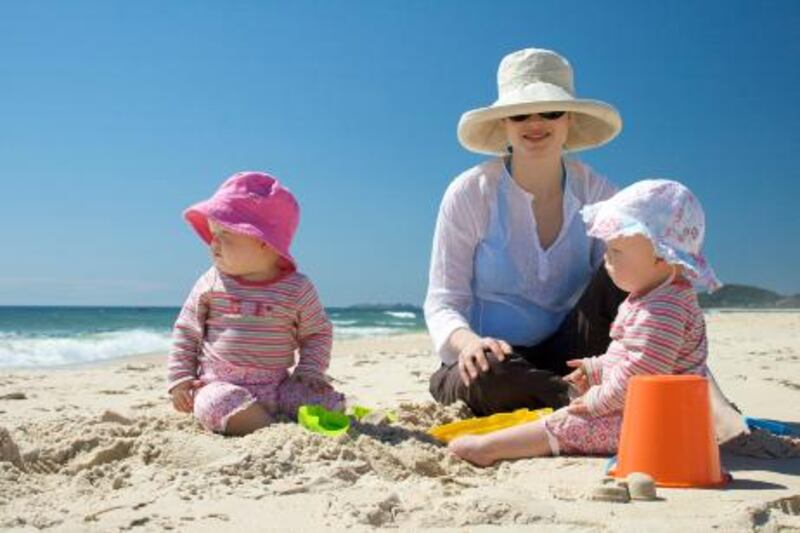It already seems impossible to open a gate in the middle of the day without incurring third-degree burns to your hand. Sweaty school pick-ups with cranky children in tow have to be followed by a cool flannel to the forehead and a shower. Yes, summer is about to arrive.
This also means there is an increase in the amount of UV radiation bathing the UAE, with summertime levels often reaching the "extreme" level as classified by the World Health Organisation's UV index. You can't feel or see UV radiation, but excessive exposure to it, particularly where children are concerned, has been shown to cause skin cancer, cataracts and other eye diseases.
However, UV radiation isn't all bad - we rely almost exclusively on exposure to the sun to create vitamin D. Insufficient vitamin D can give rise to osteoporosis, diabetes and depression. There has long been a tussle between the vitamin D lobby who, to counteract the increasing incidence of vitamin D deficiency, call for a less paranoid and evasive reaction to the sun, and cancer specialists, who warn that too much sun exposure can give rise to life-threatening melanomas.
In December last year, a "Consensus Vitamin D Position Statement" was published by, among others, the British Association of Dermatologists, Cancer Research UK and the National Osteoporosis Society, setting forth an agreed approach to sensible sun exposure. The key is little and often: not to avoid the sun completely, but not sunbathing either.
Sufficient vitamin D can be produced in most people simply by going about their everyday activities. According to the paper, "the time required to make sufficient vitamin D is typically short and less than the amount of time needed for skin to redden and burn. Regularly going outside for a matter of minutes around the middle of the day without sunscreen should be enough."
Of course, the UAE's middle of the day is a different matter, but researchers have found that vitamin D can be stored in the body for several months. So provided you have had sufficient exposure to the sun over the UAE's winter months, your stores of vitamin D should be enough to see you through the heat of the summer without having to spend too much time in the sun.
According to the World Health Organisation, children are particularly sensitive to UV radiation due both to their delicate skin and the cumulative effect of sun exposure over their lifetime. Repeated instances of sunburn increase their risks of developing skin cancer later in life.
Cancer Research UK states on its website that "the most serious type of skin cancer - melanoma - is the second most common cancer in 15 to 34 year olds." But the risk of developing these life-threatening cancers can be drastically reduced by following a few simple rules.
"The best possible thing for a baby under six months is to stay out of the sun altogether, but that's not really practicable here in the UAE," says Helen Gillespie, the practice nurse and health visitor at Infinity Clinic in Dubai. "But when you do take your baby outside, they should be wearing a hat, loose, tight-weave clothing and be shaded." Preferably, babies and children should not be out in the sun between the hours of 11am and 3pm, when the UV radiation is at its peak.
Putting a baby under the shade of a parasol by the poolside is not sufficient to protect them, advises Gillespie. "The sun can bounce off the surfaces around you: the water, the tiles and come in sideways. You have to be aware that the baby may suffer some sun exposure even under a shade." UV suits and legionnaire-style hats are great for babies and children, supplemented with sun cream on exposed skin. And while it used to be advised that you do not use sunscreen on babies under six months, the American Academy of Paediatrics now recommends that you can use some sun cream on babies' faces and the backs of their hands, says Gillespie.
Creams should have a minimum sun protection factor of 15 and a four- or five-star "broad spectrum" rating. Gillespie recommends that cream be applied 30 minutes before leaving the house so it can penetrate the skin. However, before applying it for the first time on a baby, you should carry out a patch test in case of any allergic reaction.
Persuading teenagers to be careful of the sun can be a whole different battle. Hopefully the Twilight-vampire look might encourage teenagers that "pale and interesting" is more desirable than seeking a tan. However, teenagers still encounter a lot of peer pressure to look tanned. "Remember, sunbeds are just as dangerous as tanning in the sun," says Sue Young of the Forever Young Beauty Salon at the Hilton Hotel in Abu Dhabi. "The best solution for teen tanning is to fake it. We offer full body airbrush tans, but you can buy home tanning products too which are very good."
According to the WHO, although the incidence of skin cancer in those with naturally darker skin is lower, if they have too much sun exposure they still run the risk of cataracts and other eye problems. Dark-skinned people also face the added risk that skin cancer is not diagnosed until a later and more dangerous stage.
Education and inculcating good habits early are key for children. If children know from a young age that they have to wear a hat and cream when they go out and UV suits in the pool, this will become expected, accepted and normal, says Gillespie. "In this part of the world, you need to make it part of your daily routine: you clean your teeth, you wash your hands, you put on sun cream before you go out. Then children get used to it and it becomes expected behaviour for them."





